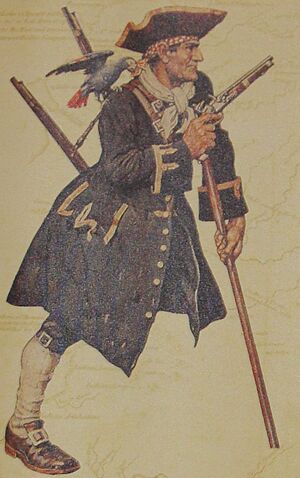Cornelis Jol facts for kids
Quick facts for kids
Cornelis Jol
|
|
|---|---|

Modern-day interpretation of Cornelis Cornelisz. Jol, as pictured in the Museo Puerta de Tierra in Campeche, Mexico.
|
|
| Born | 1597 Scheveningen, Dutch Republic
|
| Died | 31 October 1641 (aged 43–44) São Tomé, Portuguese São Tomé and Príncipe
|
| Piratical career | |
| Nickname | Houtebeen (Dutch) Perna de Pau (Portuguese) Pie de Palo (Spanish) El Pirata (Spanish) |
| Type | Corsair |
| Allegiance | Dutch Republic |
| Years active | 1620s–1640s |
| Rank | Admiral |
| Battles/wars |
|
Cornelis Corneliszoon Jol (born 1597 – died 1641) was a famous Dutch sailor and admiral. He was also known as a corsair, which is like a privateer. This means he was a sailor allowed by his government to attack enemy ships and take their goods. He got the nickname Houtebeen (meaning "pegleg" in Dutch) because he had a wooden leg. The Spanish, who were often his enemies, called him El Pirata (The Pirate).
Jol worked for the Dutch West India Company. This was during a long war between the Dutch Republic (now the Netherlands) and Spain. This war was called the Eighty Years' War. He was known for attacking Spanish ships and towns in the Caribbean and along the coast of South America.
Contents
The "Pegleg" Pirate
Cornelis Jol was born in 1597 in Scheveningen, a fishing town in the Netherlands. When he was young, he lost one of his legs. We don't know exactly how it happened. Because of this, he used a wooden leg. This earned him the nickname Houtebeen, which means "wooden leg" or "pegleg." He is one of the earliest known pirates to use a wooden leg.
Joining the Dutch West India Company
Jol joined the Dutch West India Company in 1626. He quickly became a high-ranking officer, eventually reaching the rank of admiral. He was very popular among the Dutch sailors. People at the time said he was brave, smart, honest, and determined.
Adventures Across the Atlantic
Cornelis Jol sailed across the Atlantic Ocean nine times. His main goal was to attack Spanish and Portuguese ships and settlements. These attacks happened along the coast of Brazil and in the Caribbean Sea.
Capturing Islands and Cities
On one of his early trips, Jol captured the island of Fernando de Noronha. This island is off the coast of Brazil. It remained under Dutch control for many years.
In 1633, Jol and another sailor named Diego el Mulato attacked Campeche. Campeche was a Spanish city in the Yucatán Peninsula (modern-day Mexico). They used a fleet of ten ships to raid the settlement.
In 1641, Jol sailed from Brazil to the coast of Africa. There, he successfully captured the city of Luanda in Angola. He also took the island of São Tomé from the Portuguese.
Facing the Spanish Fleet
Jol became very famous for his victories. The Spanish, however, saw him as a dangerous enemy. In 1638, he tried to capture the Spanish treasure fleet. This fleet carried valuable goods from the Americas back to Spain. He fought a naval battle with Spanish Admiral Don Carlos Ibarra near Cuba. Jol didn't capture any treasure ships that time. Some of his own captains refused to fight well because they were jealous of his promotion to admiral.
In 1639, Jol also commanded seven ships in a major naval battle. This was the Battle of the Downs, where the Dutch navy, led by Admiral Maarten Tromp, decisively defeated the Spanish fleet.
Final Voyages and Legacy
In 1640, while waiting for the Spanish treasure fleet near Havana, Cuba, Jol's fleet was hit by a strong hurricane. Four of his ships were wrecked on the shore.
After his successful campaigns in Africa in 1641, Cornelis Jol was on the island of São Tomé. He became sick with malaria and died there on October 31, 1641.
His son, also named Cornelis Corneliszoon Jol, followed in his father's footsteps. He became an officer in the Dutch navy. He even served under Admiral Maarten Tromp during the First Anglo-Dutch War (1652–1654). Today, a street in his hometown of Scheveningen is named after Cornelis Jol.
Images for kids
-
"Before the Battle of the Downs" by Reinier Nooms, ca. 1639. Cornelis Jol commanded a squadron of seven ships in this naval battle.


